| Pages:
1
2
3 |
bbartlog
International Hazard
    
Posts: 1139
Registered: 27-8-2009
Location: Unmoored in time
Member Is Offline
Mood: No Mood
|
|
So, the attempt described in my previous post was an embarassing failure: I mistook a bag of diatomaceous earth for my slaked lime. /facepalm. After
dumping the results, I tried again with a little more care. Can chloroform react significantly with acetone, given aqueous conditions and a Ca(OH)2
slurry?
To a 500ml Erlenmeyer flask, I added
12.0g chloroform (100mmol)
11.6g acetone (200mmol)
50g ice and 50g water
13g slaked lime (Ca(OH)2) (175mmol)
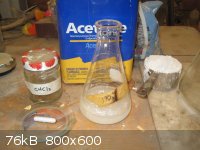
I added a stir bar and set it to stir at medium speed, leaving it for two hours. At the end of this time all the ice had melted and the temperature
had risen to about 10C. I then left it to sit at room temperature (15C in my barn) for a couple of hours before returning to it.
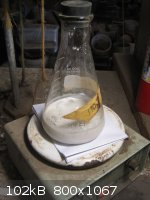
I then began adding 38g of 31% HCl in order to neutralize the base, but ended up diluting the acid with 25g of additional water in order to reduce the
exotherm. There was considerable fizzing, suggesting substantial CaCO3 contamination in my slaked lime (pretty much as expected, it is an agricultural
product and not reagent grade).
Much of the chloroform was still visible at the bottom of the flask. I transferred the contents to a separatory funnel and separated the chloroform;
it weighed 7.8g.
There is also a flocculent orange-brown precipitate in the aqueous phase. Condensation products of acetone? Hard to say.
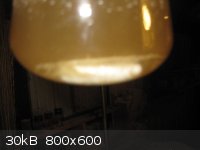 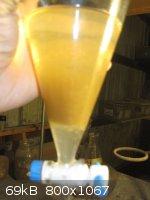
Unfortunately this result is not particularly decisive. Some chloroform may have been destroyed, but it's not beyond the realm of possibility that the
losses here were mostly mechanical or due to some dissolution of the chloroform in the aqueous phase. I will probably try this one more time, stirring
for 24 hours and then using distillation to remove the remaining chloroform; while this is less relevant to the normal course of the haloform reaction
it should at least give me a better idea of whether any reaction of the chloroform is taking place at all under these conditions.
The less you bet, the more you lose when you win.
|
|
|
barley81
Hazard to Others
  
Posts: 481
Registered: 9-5-2011
Member Is Offline
Mood: No Mood
|
|
I'm not completely sure of the rate of this reaction, but the chloroform might have hydrolyzed into formate in the basic mixture. Correct me if I'm
wrong.
|
|
|
mycotheologist
Hazard to Others
  
Posts: 154
Registered: 16-3-2012
Member Is Offline
Mood: No Mood
|
|
bbartlog: Good work. 7.8g of chloroform is a very high recovery rate, would that not be an indication that chloroform did not participate (as a
reactant) in any of the reactions that occured during the 2 hours? I wonder what reaction caused that 10 degree rise in temperature.
EDIT: I'm trying this reaction again today, I tried to dissolve 100g of Ca(ClO)2 in 500mL of water but it wasn't enough water. My lab is outdoors so
the temperature is around 10C. I added another 50mL or so of water then added the contents to a 1000 mL flask and am adding 30mL of acetone in very
small increments. This time, I'm going to distill directly out of the reaction flask but whats bothering me is the tiny amount of chloroform I'll end
up with. 30mL of acetone makes around 50mL of chloroform, but thats theoretical yield so I'll probably have less than that and have to distill a tiny
volume out of this 1000 mL flask. I'm planning on using the chloroform as a solvent so ideally, I'd need to make at least 100mL at a time to make it
worth the hassle. Is there a way I can make this more viable? For example, when the reaction has finished and all acetone is consumed, could I add
additional reactants to flask?
One problem I see is all that insoluble Ca(OH)2. I could neutralise it and turn it into a more soluble salt. It won't take me very long to rearrange
the glassware for simple distillation, whats time consuming is disassembling the apparatus and cleaning out the flask etc.
[Edited on 26-4-2012 by mycotheologist]
|
|
|
bbartlog
International Hazard
    
Posts: 1139
Registered: 27-8-2009
Location: Unmoored in time
Member Is Offline
Mood: No Mood
|
|
7.8g is less than 2/3 of what I put in, so I don't think it's *that* high a recovery rate; I agree however that it raises the suspicion that not much
at all happened, hence my notion of trying again with a much longer reaction time (and better recovery via distillation) in order to try to get a more
definitive answer.
As for the tiny volumes of chloroform for large volumes of reagent... yes. That's how it is. In order to obtain the chloroform for the experiment
described above (the previous, failed one having used up the last of what I had stored), I put two liters of bleach in my largest Erlenmeyer flask and
added 33g of acetone, yielding a comparatively very small blob of chloroform (49g) at the bottom of the flask (which was actually a very good yield).
I generally decant the vast majority of the aqueous phase before putting the rest in a separatory funnel. Distilling in such cases could improve
recovery, but it's just not worth it.
The less you bet, the more you lose when you win.
|
|
|
mycotheologist
Hazard to Others
  
Posts: 154
Registered: 16-3-2012
Member Is Offline
Mood: No Mood
|
|
Magpie must be right. What I have either isn't HTH hypochlorite, or its so old that its lost most of its chlorine content. I think its the latter
because the supplier said he no longer sells Ca(ClO)2 products so god knows how long its been there for. I did the reaction again, this time using
adequate solvent but once again, it was barely exothermic at all. This stuff is useless for the haloform reaction. I'm just going to use it as a Cl2
source. I know it works well for that, I added a few mLs of very dilute HCl to a bit of it, and it hissed and bubbled. I'll use it to make some NaClO
solution, that way at least I'll its exact concentration.
|
|
|
mycotheologist
Hazard to Others
  
Posts: 154
Registered: 16-3-2012
Member Is Offline
Mood: No Mood
|
|
Quote: Originally posted by bbartlog  | | As for the tiny volumes of chloroform for large volumes of reagent... yes. That's how it is. In order to obtain the chloroform for the experiment
described above (the previous, failed one having used up the last of what I had stored), I put two liters of bleach in my largest Erlenmeyer flask and
added 33g of acetone, yielding a comparatively very small blob of chloroform (49g) at the bottom of the flask (which was actually a very good yield).
|
Was the bleach 5% NaClO solution? I'm gonna make my own NaClO solution and was wondering if higher concentrations such as 40% could be safely used in
this reaction. I don't see why not. As long as one carefully controls the drip rate of acetone, the temperature can be controlled.
|
|
|
bbartlog
International Hazard
    
Posts: 1139
Registered: 27-8-2009
Location: Unmoored in time
Member Is Offline
Mood: No Mood
|
|
What I had was 6%. Higher concentrations can definitely be used, using your method (active cooling and gradual acetone addition). If you want to do it
like I did, adding the acetone in one fell swoop, then 10-12% is probably max, and even for that you need to prechill the reagents to 0C.
The less you bet, the more you lose when you win.
|
|
|
mycotheologist
Hazard to Others
  
Posts: 154
Registered: 16-3-2012
Member Is Offline
Mood: No Mood
|
|
After distilling, I got about 10mL of a clear, colourless liquid. I got a mild spicy odour from it, not the odour I remember of chloroform but I added
some water and it separated into 2 layers, the aqueous layer being the top one. Its definitely chloroform. Any left over acetone would have distilled
over with it so since I couldn't smell any, I assume it was all consumed. The still head wasn't fitted properly and I noticed mild leakage so thats
probably where most of the yield went. Either that or the CCl3 particles couldn't make it out of the enormous mass of Ca(OH)2 precipitate. Since there
are such massive quantities of this crude Ca(OH)2 formed during these reactions, I'm gonna keep it and try and come up with a use for it. What I love
about gas bubbling, is it usually doesn't matter how filthy and contaminated the reagents you use to generate the gas are. Its a brilliant way to
recycle chemicals that would ordinarily be disposed of, due to their high degree of contamination.
|
|
|
mycotheologist
Hazard to Others
  
Posts: 154
Registered: 16-3-2012
Member Is Offline
Mood: No Mood
|
|
Separation of acetone from chloroform
What would be the easiest way to purify chloroform that is contaminated with a small amount of acetone? First thing that comes to mind is to use a
series of liquid liquid extraction to gradually extract the acetone into the aqueous layer until there is a negligible amount of acetone left in the
chloroform. A more effective approach though would be to add some kind of drying agent that is completely insoluble in chloroform but will absorb the
acetone. Anyone know of a drying agent like this?
|
|
|
Pyro
International Hazard
    
Posts: 1305
Registered: 6-4-2012
Location: Gent, Belgium
Member Is Offline
Mood: No Mood
|
|
best would be to just add some more bleach, and in the future use bleach in excess, thats a lot easier to seperate
all above information is intellectual property of Pyro.  |
|
|
sargent1015
Hazard to Others
  
Posts: 315
Registered: 30-4-2012
Location: WI
Member Is Offline
Mood: Relaxed
|
|
Well, I did some research on it (Woelen made some good points on this in another Chemistry forum) and lab extraction is NOT going to work. Acetone
will dissolve in both water and chloroform, therefore making it incredibly difficult to separate the two entirely.
I did however find this from Wiki:
| Quote: |
Extractive distillation is similar to azeotropic distillation, except in this case the entrainer is less volatile than any of the azeotrope's
constituents. For example, the azeotrope of 20% acetone with 80% chloroform can be broken by adding water and distilling the result. The water forms a
separate layer in which the acetone preferentially dissolves. The result is that the distillate is richer in chloroform than the original azeotrope.
|
I'm not sure how reliable it is, but if you do try it and attain good results, be sure to let us know!
|
|
|
Nicodem
|
Threads Merged
12-5-2012 at 11:35 |
mycotheologist
Hazard to Others
  
Posts: 154
Registered: 16-3-2012
Member Is Offline
Mood: No Mood
|
|
Only problem is I'm not sure if there actually is an acetone in there. Its invisible and impossible to smell in such small quantities. I want to use
chloroform as a solvent and acetone would alter its solubility properties. I suppose I can always just add hypochlorite when I'm done, then distill.
BTW a single liquid liquid extraction wouldn't get rid of much acetone, but a series of them would. The partition coefficient determines what
percentage of the acetone will go into the water phase and what percentage goes into the chloroform phase. So lets say I have 100 mL of chloroform
with 20 mL of acetone in it. Lets say the partition coefficient is 50:50. If I add 100 mL of water, then 10 mL of acetone goes into the water phase. I
dump the water phase and add another 100 mL of water. Now 5 mL goes into the water, leaving only 5 mL in the chloroform. If I do this enough times, I
can bring the amount of acetone in the chloroform down to microlitres. I think it works even better if I use more water. For example, if I add 500mL
of water to the 100mL of acetone, I think even more of the chloroform will go into the water phase.
I just got a good idea for producing large volumes (i.e. 500mL at a time) of chloroform very easily. At first I was thinking about using one of those
glass demijohns they use for brewing beer:

for making CCl3 from NaClO but decanting is a pain in the ass and surely tilting the vessel to decant causes some of the chloroform to mix with the
water and thus, increases the amount lost. Heres a way better idea. Use one of the 10 litre HDPE water containers:

and make a small hole at the bottom and make it into a stockcock type device. That way you simply make a big batch of CCl3, then open the stopcock
and slowly drain the chloroform out of the container. To make the end point easier to see, you could add food colouring to the aqueous layer
(assuming it doesn't dissolve in chloroform). Well, theres nothing revolutionary here, I'm just talking about making a big, opaque seperatory funnel.
[Edited on 12-5-2012 by mycotheologist]
[Edited on 12-5-2012 by mycotheologist]
|
|
|
mycotheologist
Hazard to Others
  
Posts: 154
Registered: 16-3-2012
Member Is Offline
Mood: No Mood
|
|
I've been making chloroform using this 5% NaClO solution my neighbour gave me and I'm starting to get the hang of it. Whats weird though is the
chloroform at the bottom of the flask (a 1L erlenmeyer) is white and goopy, it looks almost like vaseline. It smells like chloroform but why is it so
viscous and white? Is it some kind of emulsion? I'm guessing I can just distill it and get pure chloroform (unless theres acetone in there) but I'm
just wondering why the CCl3 looks like this.
|
|
|
watson.fawkes
International Hazard
    
Posts: 2793
Registered: 16-8-2008
Member Is Offline
Mood: No Mood
|
|
You
very much should learn about thermal runaway right now. Scaling up haloform reactions is notorious, even here, for being problematic.
|
|
|
mycotheologist
Hazard to Others
  
Posts: 154
Registered: 16-3-2012
Member Is Offline
Mood: No Mood
|
|
Quote: Originally posted by watson.fawkes  | | You
very much should learn about thermal runaway right now. Scaling up haloform reactions is notorious, even here, for being problematic.
|
What I have in mind is increasing the quantity, not the rate. The temperature can kept low by adding the acetone slowly.
|
|
|
NiCoLi_BrLiNTe
Harmless

Posts: 18
Registered: 22-5-2013
Location: just outside the walls of Warwick castle
Member Is Offline
Mood: perplexed
|
|
Help!!! I guarantee this will have you baffled!
Right firstly, thanks in advance for any help or advice you can offer. Basically i'm having some serious issues pulling off a haloform reaction with
both sodium hypochlorite and calcium hypochlorite. I first tried to do it using 4.5% household bleach. Domestos extended kill brand to be precise. I
wasn't having much luck with this, I assumed because of all the thickening agents and surfactants. I then tried to make my own both through
electrolysis and gassing NaOH with chlorine, but still nothing. finally I decided to switch to calcium hypochlorite, technical grade from a actual
chemical supplier, still nothing, the reaction vessel didn't even rise by a single degree in temperature! Assuming it must have been poor quality, I
decided to pay the excess and get some from one of the international chemical supply houses. As such I purchased 10 litres of sodium hypochlorite from
VWR. This is graded as having less that 10 ppm of contaminating factors and is clearly extremely strong bleach. I also thought it may be something to
do with my acetone (although its fairly easy to tell acetone) so bought some 99.9 percent assay lab grade acetone as well. I brought the temperature
down to about -5C and mixed near stoichiometric amounts (with the NaClO in slight excess) in a dark, super clean vessel. Much to my absolute disgust
still nothing. I've tried mixing them with out cooling to see I can tell if there reacting from the heat generation, and again not even a single
degree rise.
This has made me start to question the fabric of reality, I'm going to end-up drinking the acetone and hypochlorite to see if I can regurgitate
chloroform.
Also, I couldn't upload any pictures so I've attached them as files instead, just so you might be able to tell me if I'm doing somthing wrong, or if
i've simply gone insane!
Thanks again,
NiK
[Edited on 19-7-2013 by NiCoLi_BrLiNTe]
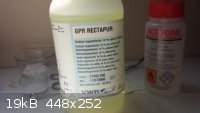 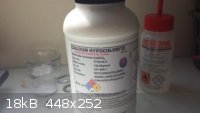 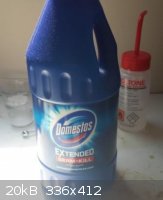 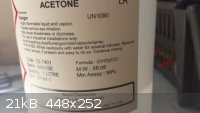
|
|
|
Bot0nist
International Hazard
    
Posts: 1559
Registered: 15-2-2011
Location: Right behind you.
Member Is Offline
Mood: Streching my cotyledons.
|
|
In my experiance, 10ml of cold acetone is added to 300ml cold (from the freezer, near 0°C) 8% commercial bleach with mag stirring in an
icebath. After 5 minutes or so, the solution becomes turbid and cloudy, then from yellow to clear, and a blob of about 8ml of chloroform can be sep
funneled off the bottom. Good luck, and yes, UTFSE for more data. Its been covered to death.
[Edited on 19-7-2013 by Bot0nist]
U.T.F.S.E. and learn the joys of autodidacticism!
Don't judge each day only by the harvest you reap, but also by the seeds you sow.
|
|
|
NiCoLi_BrLiNTe
Harmless

Posts: 18
Registered: 22-5-2013
Location: just outside the walls of Warwick castle
Member Is Offline
Mood: perplexed
|
|
Thanks, I've been using either 100mls of a saturated calcium hypochlorite solution, ice cold - to 40mls of pure ice cold acetone. Alternatively I've
been using 1litre of 7% sodium hypochlorite to 33mls of acetone. How hot should the reaction get? Using these ratios on a test tube scale but without
cooling, I not noticed any temperature increase or any other sign of a reaction for that matter.
Also I have been reading through the other threads on this topic for over a week now in quite some depth, as well as using other sources. I can't find
any reason why it shouldn't work. Not only is there no mention of this type of problem in conventional textbooks, no one else seems to behaving quite
the same problem. However, it didn't occur to me to simply add this post to an existing thread, so my apologies for that and I'll be sure to bare that
in mind next time I go to post something!
Thanks,
Nik
|
|
|
Bot0nist
International Hazard
    
Posts: 1559
Registered: 15-2-2011
Location: Right behind you.
Member Is Offline
Mood: Streching my cotyledons.
|
|
It is exothermic, and extensive cooling is needed. Pre cool your reagents and use an icebath, then report back. With just 10ml of acetone, the outside
of the flask get noticably warm when the solution gets cloudy. Also be patient. It takes several minutes of stirring and cooling before the reaction
takes off.
U.T.F.S.E. and learn the joys of autodidacticism!
Don't judge each day only by the harvest you reap, but also by the seeds you sow.
|
|
|
bbartlog
International Hazard
    
Posts: 1139
Registered: 27-8-2009
Location: Unmoored in time
Member Is Offline
Mood: No Mood
|
|
So 33 ml of acetone = 26g = about 450mmol.
1 liter of 7% bleach = (1.1kg * 0.7) = 77g sodium hypochlorite = about 1030mmol.
Your amounts here are not near stoichiometric and your sodium hypochlorite is not in excess (rather your acetone is). The correct molar ratio is 3:1
bleach to acetone. It matters for two reasons: first, excess acetone may result in some 1-chloroacetone being produced that then doesn't get
completely chlorinated (thus consuming the limiting reagent, bleach, to no purpose). Second, if there is acetone remaining at the end, it can react
with the chloroform under sufficiently basic conditions, further damaging yield.
However, this doesn't explain why you didn't see a rise in temperature, and it surprises me that you got no chloroform at all. It is true that if you
start with ice cold reagents and mix them immediately on addition, it can take quite some time for the reaction to get going (tens of minutes), which
is why people sometimes just leave it overnight.
I suggest you proceed as follows: take one liter of your 7% bleach (chilled to 0C) and gently pour 22ml of acetone (room temperature) on top of it (so
that it sits in a layer atop the bleach). Swirl gently every minute or so, just to mix a little at the boundary.
(edited to correct relatively irrelevant error in stoicho calculation)
[Edited on 19-7-2013 by bbartlog]
The less you bet, the more you lose when you win.
|
|
|
bfesser
|
Threads Merged
19-7-2013 at 07:56 |
Sublimatus
Hazard to Others
  
Posts: 108
Registered: 8-6-2011
Member Is Offline
Mood: No Mood
|
|
NiCoLi_BrLiNTe, at least to my mind, your results suggest to me that one of your materials is not what it's labelled as. This reaction is spontaneous,
and quite exothermic. In my experience, I've always been more concerned with slowing this reaction down, rather than trying to get it started.
Have you done anything to confirm the identity of your materials? I know it seems a silly suggestion, but it shouldn't be too much work to achieve. If
you are indeed mixing acetone and NaOCl solution (with NaOCl in excess), and no reaction takes place, then as the title of your previous thread said,
I am baffled.
|
|
|
Fantasma4500
International Hazard
    
Posts: 1681
Registered: 12-12-2012
Location: Dysrope (aka europe)
Member Is Offline
Mood: dangerously practical
|
|
Quote: Originally posted by mnick12  | | Solid sodium hypochlorite? Hmmm considering the instability of hypochlorites I doubt you have pure sodium hypochlorite. |
actually, it is possible to make solid NaClO
im very certain there will be some way to seperate the NaCl and NaClO3 from the NaClO
the reason i know this is possible is because i have evaporated water off to get a powder, in which was reacted with HCl.. the reaction i got was not
by NaClO3
also when i added water to it all again, i got the classic bleach smell
starting product was approx. 5% NaClO
also for KClO3 synth. i have needed to boil down the water and completely away several times, still at this point a clear bleach smell was noticed,
several times dried by boiling the water off
it is possible for sure, the question would be how to purify it
|
|
|
NiCoLi_BrLiNTe
Harmless

Posts: 18
Registered: 22-5-2013
Location: just outside the walls of Warwick castle
Member Is Offline
Mood: perplexed
|
|
I'll try it again using the above mentioned ratio's. also I haven't had it an a stir-plate so maybe that will help. As far as testing the reagents,
the acetone is definitely acetone, it smells like it, is highly flammable and tests positive as a ketone with Brady's reagent. The sodium hypochlorite
smells like bleach, and bleaches litmus paper; additionally you would hope coming from a supplier like VWR it's what it says it is. the rest of the
stuff i've tried could well be flour for all I know. However, I try again with the information you guys have already provided, then if it's still not
working I'll see if I can go into Uni at some point and use an IR spec or something.
Anyway, I'm off to fill the freezer with chemicals! I'll post images of what I'm doing; maybe that will help identify if I'm making a mistake
somewhere.
Thanks,
NiK
|
|
|
Magpie
lab constructor
    
Posts: 5939
Registered: 1-11-2003
Location: USA
Member Is Offline
Mood: Chemistry: the subtle science.
|
|
I agree that this synthesis should not need kickstarting - just the opposite. On my first try I had a runaway. I used HTH calcium hypochlorite pool
chlorinator and acetone, no NaOCl was needed. Are you following an established procedure? Surely there is one in the forum library books.
Edit: see Norris (p. 105) and Vogel
[Edited on 20-7-2013 by Magpie]
The single most important condition for a successful synthesis is good mixing - Nicodem
|
|
|
NiCoLi_BrLiNTe
Harmless

Posts: 18
Registered: 22-5-2013
Location: just outside the walls of Warwick castle
Member Is Offline
Mood: perplexed
|
|
Yeah, I've recently modified it according to the 1:3. Ratio surggested above! The sodium hypochlorite and calcium hypochlorite aren't used in the same
reaction. After failing with calcium hypochlorite, I moved to the sodium! Although, last night after I posted on here, I tried again. This time
instead I used the new ratio, and I hadn't had a chance to get the reagents as cold as I would have liked, about 0*C. Finally I used a mulithead
adapter and set up for reflux, After the reaction had spent half an hour mixing an high speed I re-set up for simple distillation. From the first
batch I got about 5mls. But then I put more calcium hypochlorite in to the hot flask and added the acetone. It started boiling all by its self. I
think I must have got about 7ml from that run.
I've take pictures, so I'll up load them when I get on my PC next.
|
|
|
| Pages:
1
2
3 |